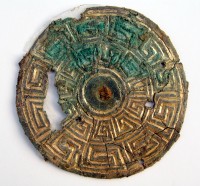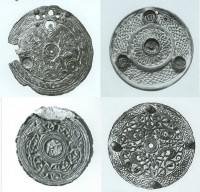 Last year, the grave of a wealthy 10th century woman was discovered in Enghøj on the Jutland peninsula of Denmark. Archaeologists from the Museum East Jutland were excited to find a gilt bronze buckle of Irish or Scottish manufacture in the grave. The woman wore it to pin the ends of her petticoat together, but it wasn’t originally a brooch. Made in the 9th century, the 2.4-inch disk once adorned a Christian reliquary or other container of sacred objects before it was pillaged by Viking raiders. Less than a hundred years later, it was the highly prized treasure of a rich Norsewoman, so highly prized that it was buried with her.
Last year, the grave of a wealthy 10th century woman was discovered in Enghøj on the Jutland peninsula of Denmark. Archaeologists from the Museum East Jutland were excited to find a gilt bronze buckle of Irish or Scottish manufacture in the grave. The woman wore it to pin the ends of her petticoat together, but it wasn’t originally a brooch. Made in the 9th century, the 2.4-inch disk once adorned a Christian reliquary or other container of sacred objects before it was pillaged by Viking raiders. Less than a hundred years later, it was the highly prized treasure of a rich Norsewoman, so highly prized that it was buried with her.
This was an unexpected and significant discovery, because while precious objects from the British Isles have been found before in Viking graves, they are very rare and all but unheard of in Denmark. None of the experts who examined the buckle knew of anything like it in the Danish archaeological record. The Irish/Scottish origin and style of ornamentation make it a unique find in Denmark. The artifacts most comparable to the Enghøj buckle were found in Norway, like this Celtic brooch unearthed from a 9th-10th century barrow in Lilleberge, or this crozier fragment found in Romsdal. Swedish Vikings tended to go east for their raids, while the Norwegians roamed the North Atlantic islands, Scotland, Ireland and northern England, so it makes sense that the few surviving Celtic artifacts pillaged in those areas are concentrated in Norway.
 Museum East Jutland archaeologist Ernst Stidsing, who led the excavation at the site, hypothesized that the woman in the Enghøj burial might have some kind of link to Norway. Strontium isotope analysis on her teeth could pinpoint where she was born and spent her childhood.
Museum East Jutland archaeologist Ernst Stidsing, who led the excavation at the site, hypothesized that the woman in the Enghøj burial might have some kind of link to Norway. Strontium isotope analysis on her teeth could pinpoint where she was born and spent her childhood.
“I’m pretty excited about the outcome of the analysis,” says Stidsing. “Especially as the Norwegian Vikings were often on expeditions to the north of England. It’s exciting that a woman may have come from Norway and have lived part of her life in Jutland [west Denmark].”
Archaeologist Jens Ulriksen of the Museum Southeast Denmark was also intrigued by the prospect of the lady’s possible Norwegian origin.
“It’ll be exciting if we find some indication that she was raised, married, and settled over greater distances. We know that Danish kings married Slavic princesses from 900 AD,” he says.
“It wouldn’t surprise me that there was an exchange, but it’s worth gold to have it confirmed. And you might see some dynastic connections across the Nordic region,” says Ulriksen.
Well, the strontium isotope analysis results are in and the woman buried in Enghøj was indeed born and raised in Norway, southern Norway, to be precise.
She probably wasn’t a princess, but she was buried with expensive grave goods beyond the Celtic brooch. There were several bronze buckles, silver jewelry and a strand of glass and metal beads. She would certainly have been one of the richest people in town, perhaps the wife of a local chief or regional leader. As with the Slavic princesses mentioned by Ulriksen, marriage could well have been the reason for the woman’s move to Denmark. Her pillaged petticoat pin heirloom indicates she came from a wealthy family, the kind of family that might arrange a marriage with a distant Danish potentate.